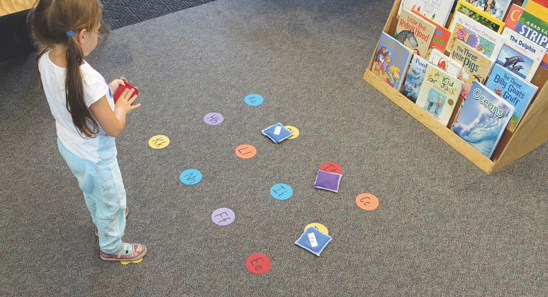Letter/Sound Recognition Floor Game


The very first time I placed a set of SitSpots down inside my kindergarten classroom we all did the happy dance...not just me... but my kids and my custodian as well - once he realized that the spots weren't duct tape. What a difference these little spots made to our day...our week... and ultimately....our school year.
The excitement and relief on my part didn't stop there! As the creator of these amazing little spots, it didn't take me long to realize that there were a lot more places we could go with SitSpots.
The real magic happened when I used SitSpots for "Floor Games". It was absolutely incredible to see the changes that transpired to my students' engagement levels as soon as I gave my students the option of replacing their writing tools with a different kind of tool used for skills practice. Instead of using pencils, markers, and/or crayons for skills practice, they now had the option of using beanbags, nerf balls, jumps, etc. Their engagement levels increased tenfold... they couldn't wait to "play". Once I realized the impact these games had on learning, I began creating additional floor games. All of these games were content driven and related to the Common Core State Standards, and I basically transferred the content from the practice worksheets onto the spots (one word, letter, number, etc. per spot).
Here's a floor game that I'm hoping will act as a springboard for implementing floor games into your classroom. It's a step toward managing those wiggles and giggles while improving academic skills ...but a very important one indeed.
Additional floor games will be posted monthly. All you'll need to do is modify the content of these games to fit the needs of your class.
Objective of all the Floor Games:
To increase student engagement levels and practice academic content skills
Directions:
Materials needed:
- 12-SitSpots circles in various colors
- 2-SitSpots paw print shapes
- 1-Sharpie Paint Pen (permanent marker - can not be removed)
- Beanbags (3-5) or other objects
Print one upper/ lower case letter (i.e. Aa) onto each spot or piece of tape (that will be placed on top of spots if wanting to reuse them) or modify this content to fit the needs of your students
Use paw prints for students to stand on when tossing the beanbags
One student identifies a letter and “calls it out” by name and phonetic sound before tossing the beanbag onto it
Each student gets 3 tosses
Students who miss the targeted letter walk over to that letter and stomp on it while calling the letter out again.
Low-level students may need a student monitor for additional assistance.
Reminder: Print content that is specific to the curricular needs of your students (i.e. site words, vowels, numbers, shapes, etc.) while using the same guidelines as above.
For additional information on floor games click here.

Comments on this post (4)
I’m a big fan! I use the alphabet set for lining up and each kiddo has their own letter. Next plan: giant hopping numberline for addition and subtraction practice. These are a lifesaver for any (but especially this first year kinder) teacher.
— Cassandra Hammer
I teach K-6 General music. These are terrific for marking areas of the room and pathways through the xylophones.
I’m thinking a variation of the twister game could be to identify musical symbols (like “site words” for music!) and for pitch identification, or even to play a melody as student walks from spot to spot with their recorder.
— Katherine Iooss
Thanks for sharing your fantastic math game ideas! This is just what is needed as springboard ideas for teachers. I’ll be posting additional floor games monthly in the hopes that teachers will use them for skills practice because students love moving while they’re learning. Thanks again!
— Joyce
I am going to send this post to our primary teachers. I teach 4th and 5th (bounce from year to year). I receive interesting looks from some educators and admin when they come into my room because there are sit spots for my students in the front of the room. I use them because I use to say turn to a partner and even if I asked them to find a new one they would talk to the same people. Now, I say turn to your color partner or shape partner. This does take some thinking through at the start of the year since numbers NEVER are the same from class to class. However, it has worked wonders.
After reading this post, I have another idea to add. Fridays for math, we play a game where students work in teams to solve the book problems. In order to know what problem their team needs to work they toss a squishy ball at a number mat. I could number the spots I have and just use that space. Then I could use the numbers to say anyone with the multiple of 2 answers or factors of 15 when they are sitting up front. THANKS for sparking my brain cells!! I need to add these ideas into my next year’s folder so they are not forgotten.
— Kimberly Remmers